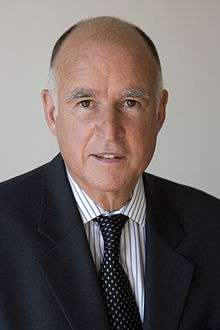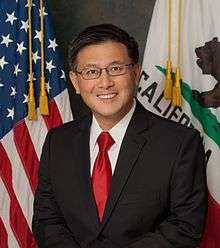California executive branch
The California executive branch consists of elected officers and other offices and officers. The elected executive officers are:
-

Jerry Brown (D)
Governor
Governor
Agencies under the direction of a secretary that report directly to the Governor are cabinet-level agencies, to which other agencies are subordinate:[1]
- Governor
- Office of the Inspector General
- Military Department
- Department of Food and Agriculture
- Department of Finance
- Department of Veterans Affairs
- Secretary of Business, Transportation and Housing Agency
- California Department of Alcoholic Beverage Control
- California Department of Corporations
- California Department of Financial Institutions
- California Highway Patrol
- California Department of Housing and Community Development
- California Housing Finance Agency
- California Department of Managed Health Care
- Department of Motor Vehicles
- California Department of Real Estate
- Office of Real Estate Appraisers
- Department of Transportation
- California Traffic Safety Program
- Secretary of Emergency Management Agency
- Secretary of Environmental Protection Agency
- Secretary of Health and Human Services Agency
- Department of Aging
- Department of Alcohol and Drug Programs
- Department of Child Support Services
- Department of Community Services and Development
- Department of Developmental Services
- Emergency Medical Services Authority
- Department of Health Care Services
- Managed Risk Medical Insurance Board
- Department of Mental Health
- Department of Public Health
- Department of Rehabilitation
- Department of Social Services
- Office of Statewide Health Planning and Development
- Secretary of Labor and Workforce Development Agency
- Agricultural Labor Relations Board
- Employment Development Department
- Department of Industrial Relations
- Workforce Investment Board
- Secretary of Natural Resources Agency
- CALFED Bay-Delta Program
- Department of Boating and Waterways
- California Coastal Commission
- CA Coastal Conservancy / CA Tahoe Conservancy / Santa Monica Mountains Conservancy
- Colorado River Board of California
- Department of Conservation
- California Conservation Corps
- California Energy Commission
- Department of Fish and Game
- Department of Forestry and Fire Protection
- Department of Parks and Recreation
- Department of Water Resources
- Secretary of State and Consumer Services Agency
- California African American Museum
- Building Standards Commission
- California Department of Consumer Affairs
- Department of Fair Employment and Housing
- Fair Employment and Housing Commission
- Franchise Tax Board
- Department of General Services
- Office of the Insurance Advisor
- California State Personnel Board
- Public Employees' Retirement System
- California Science Center
- Teachers' Retirement System
- Secretary of Department of Corrections and Rehabilitation
- Adult Operations Division
- Adult Programs Division
- Juvenile Justice Division
- Corrections Standards Authority
- Board of Parole Hearings
- State Commission on Juvenile Justice
- Chief of Staff
- California Office of Administrative Law
- California Medical Assistance Commission
- California Department of Human Resources
- California Office of Planning and Research
- California Service Corps
Independent entities
- State Board of Education
- Insurance Commissioner
- Secretary of State
- Lieutenant Governor
- State Controller
- State Treasurer
- State Board of Equalization
- Attorney General
- Board of Governors, Community Colleges
- California Postsecondary Education Commission
- California Student Aid Commission
- Trustees of State Universities
- University of California Board of Regents
- Fair Political Practices Commission
- California Gambling Commission
- State Lands Commission
- California Lottery Commission
- Public Employment Relations Board
- California Public Utilities Commission
- California Transportation Commission
Overview
Generally, a Cabinet-level head of an agency in California holds the title of "secretary", while the head of a department holds the title of "director." Exceptions include the head of the Department of the California Highway Patrol, whose title is actually "commissioner."
The vast majority of state government agencies and departments are headquartered in Sacramento or in parts of Sacramento County near the city of Sacramento; in turn, the larger agencies and departments also have local offices around the state which report to headquarters in Sacramento. Notable exceptions include the California Public Utilities Commission and the California Department of Industrial Relations, which are both headquartered in San Francisco.
History
Other defunct statewide elected offices that no longer exist include the Comptroller (which became Controller in 1862), the Surveyor General (1849–1926), and the Clerk of the Supreme Court.
In June 2012, Governor Jerry Brown obtained approval from the Legislature to proceed with a reorganization plan.[2] By July 2013, the business and housing components of BTH will be consolidated with the consumer components of SCSA to form the new Business, Consumer Services and Housing Agency; the remainder of SCSA and the Technology Agency will merge into the new Government Operations Agency; and the transportation components of BTH along with the formerly separate California Transportation Commission will become part of the new Transportation Agency.
See also
References
- ↑ California state government. The executive branch. 2008 Dec 18. Accessed 2008 Dec 29.
- ↑ Office of the Governor, Governor Brown's Government Reorganization Plan Becomes Law, 3 July 2012.






